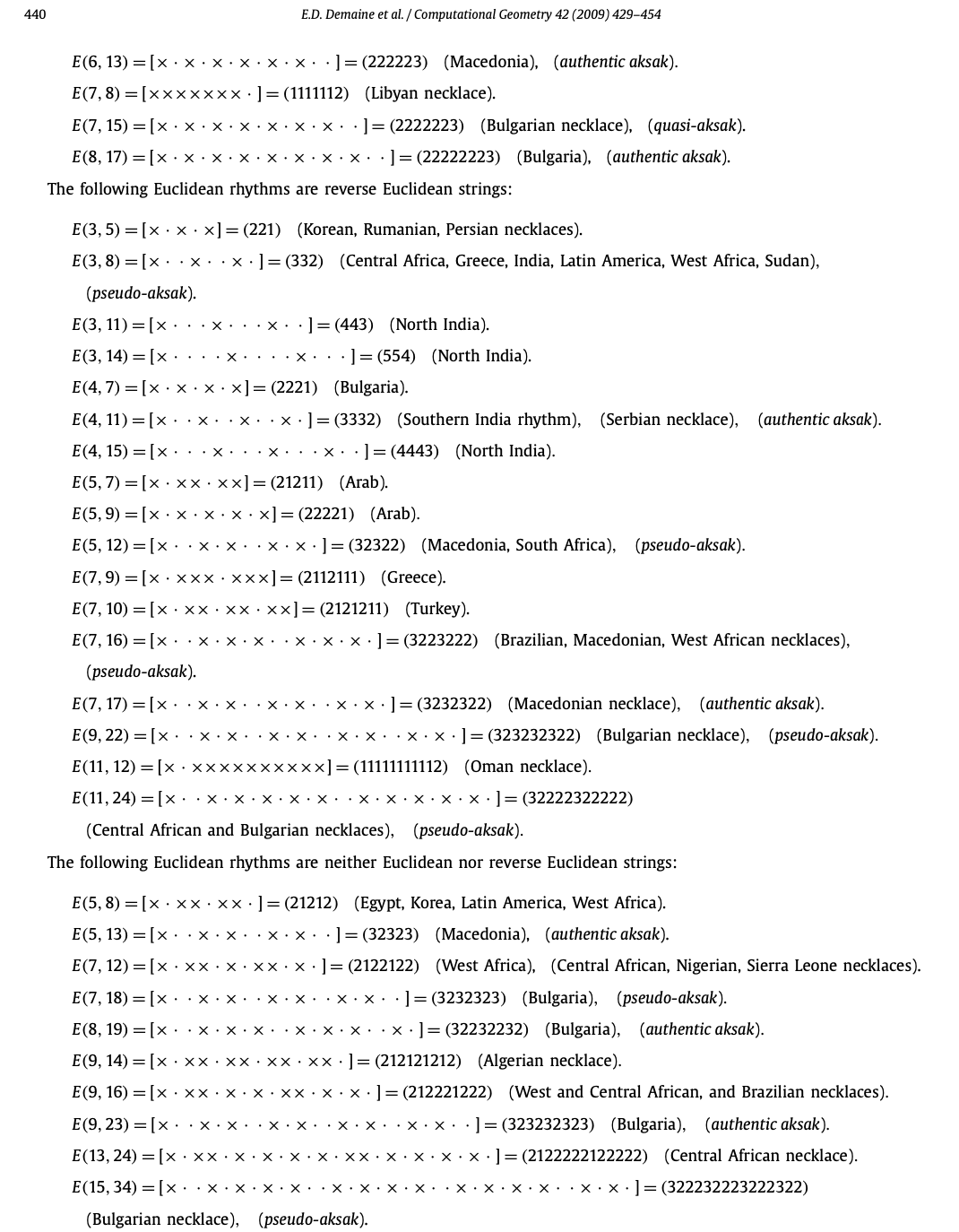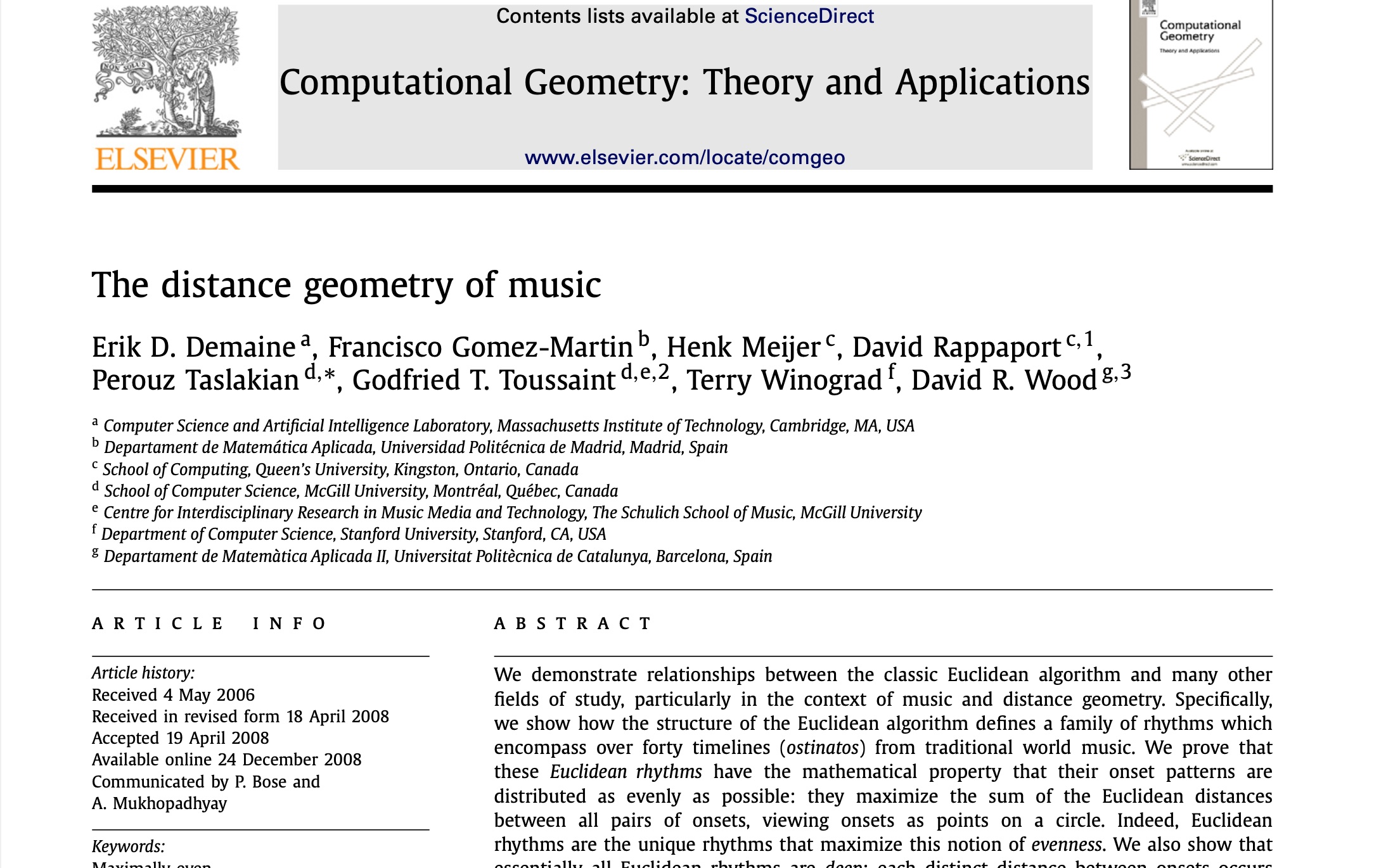From Classics to Colonialism
via drum circles
Ben Swift
19 Apr '21
we acknowledge and celebrate Australia's First Peoples on whose traditional lands we meet, and pay our respect to the elders past and present
outline
part un: Euclid’s algorithm
part deux: sounding bodies and Euclidean Rhythms
part trois: what does it all mean?
391 578
what’s the biggest number which divides evenly into both of these numbers?
the Euclidean algorithm
the Euclidean algorithm for computing the greatest common divisor of two integers is one of the oldest known algorithms (circa 300 B.C.)
first described in Euclid’s Elements, Proposition 2, Book VII
independently discovered in several other places (China, India)
granddaddy of all algorithms, because it is the oldest nontrivial algorithm that has survived to the present day
Donald Knuth, TAOCP Vol. 2
📸 Brian Flaherty for The New York Times
in plain English
To find the greatest common divisor of two numbers (a and b), repeatedly replace the larger of the two numbers by their difference until both are equal. This final number is then the greatest common divisor.
(source)
To find the greatest common divisor of two numbers (a and b), repeatedly replace the larger of the two numbers by their difference until both are equal. This final number is then the greatest common divisor.
why?
early on: tiling, astronomy, calendars
these days: many applications (e.g. number theory, cryptography)
geometric visualisation

animation from Wikipedia
in code
(define (gcd a b)
(if (= a b)
a
(gcd (min a b) (abs (- a b)))))
in code (a bit more efficient)
(define (gcd a b)
(if (= a 0)
b
(gcd (modulo b a) a)))
rhythmic notation
euclid(3,8)
same basic idea as Euclid, although attributed to Bjorklund
euclid(3,8)
aka: cuban tresillo
euclid(5,12)
euclid(5,12)
aka: South African Venda, Macedonia, Central African Republic, Tool's Schism and many more...
euclid(5,8)
aka: cuban cinquillo
Line up the boxes in one row (ones on the left), then move the rightmost zeroes “under” the left-hand ones.
If there’s more than one short (“hanging chad”) column on the right, take as many of those short columns as you can and move them to below the tallest (left-hand) columns—and repeat this process until there’s no more than one short column.

paper “results”
a simple algorithm for generating Euclidean rhythms
a laundry list of examples of these rhythms “in the wild”
proofs of a number of “nice” mathematical properties of Euclidean rhythms
some kite-flying about the relationship between said nice properties and the human cultural practices associated with musicmaking
musicologists:
not all widely-used rhythms in the world are Euclidean
algorithmic composers:
here’s a low-dimensional (2–3 parameter) interface for generating a wide range of interesting-sounding and culturally-significant rhythms to get people dancing
…such rhythmic structures [Euclidean rhythms] can be fruitfully regarded not only as retentions of African musical and cultural heritage, but also as a way of theorizing the threads of continuity that exist between many of the disparate musics and cultures that have shared African roots, but have been radically altered by the passage of time and cross-cultural contact and musical hybridity.
Stewart, J (2010). Articulating the African Diaspora through Rhythm: Diatonic Rhythms, Nested Looping Structures, and the music of Steve Coleman
The rules of American commercialism permit us to circumvent indigenous labor, employing indigenous know-how to re-construct crude facsimiles of sacred objects and sophisticated musical instruments. The commercialisation of the pseudo-African Drum is socially, ethically and legally upheld by our moral framework. It is, however, in violation of the ethic of the ethnic Drum.
Friedberg, L (2003). Drumming for Dollars
The Contours
📸 Motown Museum
Boston Dynamics' "terrifying" robotic dogs have been put to work by at least one police agency
November 27, 2019
📸 Charles Krupa/AP
Ben said the Euclidean algorithm is racist!
well, maybe… but that’s not the main point here
you learned it earlier—I saw you—so you’re implicated
algorithms (even simple ones!) can give us leverage in cultural domains, can/how do we use it safely, sustainably, at scale?
Machine learning is like money laundering for bias.
Maciej Cegłowski, The Moral Economy of Tech
what did you learn?
Euclid’s algorithm!
To find the greatest common divisor of two numbers (a and b), repeatedly replace the larger of the two numbers by their difference until both are equal. This final number is then the greatest common divisor.
yes, it will be on the final exam
</section>
